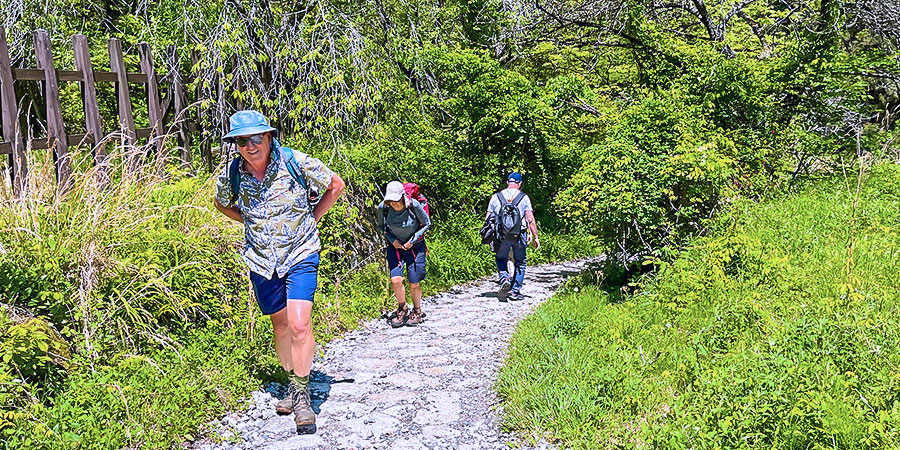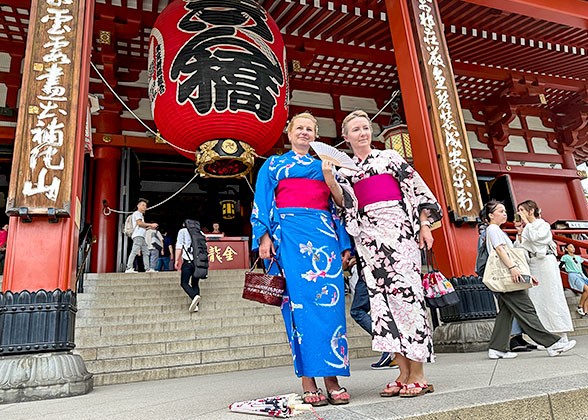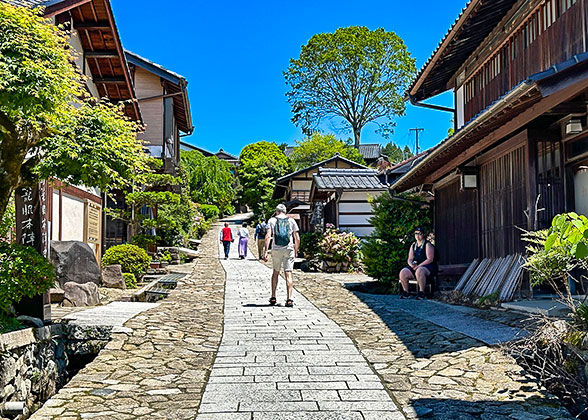Nakasendo Way Hiking – Between Magome & Tsumago
The section between Tsumago (Tsumago-juku) and Magome (Magome-juku) is the most visited part on Nakasendo Way in Japan, the southern trail segment of Kisoji trail. It’s of course the best-known section on Nakasendo Way, appealing to a large number of hikers with the original forests, old trail, and tranquil post towns tracked back to Edo Period (1603-1868 AD).Kisoji is the most beautiful and interesting part on Nakasendo Way, with 11 post towns in Kiso Valley. Magome is the southernmost post town of Kisoji trail, as well as the No.43 post town on Nakasendo Way. As for Tsumago, it’s the No.42 post town on Nakasendo Way.

Hiking on Nakasendo Way
|
The Easier Route: Magome → Tsumago
On the section between Magome and Tsumago, it is easier to start from Magome and go northwards to Tsumago.There is a high point on the trail, which is called Magome Pass (馬籠峠), aka Magome-toge Pass or Magome Mountain Pass sometimes. It’s closer to Magome, so you will go uphill less if starting from Magome. Starting from Tsumago, there would be 3.3-km (2-mile) uphill trail more.
Points of Interest on the Trail
Magome
Magome, is a popular post town for hiking on Nakasendo Way, nearby the southern entrance of Kisoji in the mountains. The street of Edo Period is reproduced, making you feel like going back the age about 400 years ago. It is completely a paradise for shutterbugs, with stone-paved roads and slopes, traditional houses, old watermill & water channels, seasonal flowers, and luxuriantly green woods. Also, a few restaurants and stores of local specialties make the small town lively. It’s the birthplace of eminent writer Toson Shimazaki, Toson Memorial Museum there is worth a visit if you are interested in Japanese literature.

|
Magome Pass – the Highest on the Section
Leaving Magome and heading to Tsumago, you will get to Magome Pass soon after a relatively steeper uphill trekking. Magome Pass is the highest site on the trail between Magome and Tsumago, at an altitude of 801 meters (2,628 feet). Getting to the elevation of 790 meters (2,592 feet), you’ll find the elevation sign as well as a stone monument by trail. On the mountain top, it would be great to overlook the stunning landscapes in the surroundings.After that, you will walk through a long gentle slope down to Tsumago.
Ichikokutochi Tatebachaya – Free Rest Area
It’s the only free teahouse for resting on the trail between Magome and Tsumago. Each hikers on the way are welcomed to take a rest there, with hot tea offered for free. It’s not a modernized house at all, but an old one preserved since the middle Edo Age. It seems that you were a traveler in that time, with a leisurely experience of the local life style.
|
|
|
Odaki & Medaki Waterfalls
Halfway on the slope to Tsumago, you would see the sign of Odaki & Medaki Waterfalls, and the beautiful scenery of waterfalls in the wild is pretty spectacular. Odaki & Medaki Waterfalls, male and female falls literally, is a couple of waterfalls down the cliff. The two waterfalls are not far apart, and have been taken as a pilgrimage site for couples in Japan apart from the incredible scenery, since the outstanding writer Eiji Yoshikawa made it a romantic background for the legendary samurai Miyamoto Musashi.Shrines & Buddhist Statues along the Way
In addition to the lush natural beauty along the trail, there are also small shrines and statues of Buddha out of nowhere. It’s diverting to explore these surprising sites on your trekking journey.Kumano-jinja Shrine south to Magome Pass, Kurashina-jinja Shine by Odaki & Medaki Waterfalls, and more nameless shrines and temples would give more fun into your hiking trip. You may also imagine that travelers prayed for smooth trip or other blessings on their journey in the ancient time.

A Roadside Shrine
|
Fujihara Family Residence
Reaching Otsumago (大妻籠), only 1 km (1,094 yards) away from Tusmago, the Fujihara Family Residence is visit-worthy. It is an oldest wooden residences in Nagano Prefecture, and reported to be dated back to mid-17th century. It’s good to learn the living style of Japanese hundreds years ago.What’s more, many inns and lodges of Tsumago are built at Otsumago, in a traditional structure along the exquisite street.

Otsumago
|
Tsumago
Getting to Tusmago, you might feel the time has stood still. It’s just like in the Edo Age all the same, as the electric wires and more power facilities are hidden. You can take a stroll around the old town, learn local life and history in the museum, try the homemade dishes in a snack bar.Luggage Delivery Service Between Tsumago and Magome
The tourist information centers provide a service to deliver your hand baggage. If you go from Magome and send your luggage in the morning before hiking, you can pick it up at Tsumago in the afternoon. Likewise, if you ask to deliver your luggage at Tsumago, you can take it back at Magome. The luggage can be sent to Otsumago as well.|
Service Period |
March 20th – November 30th |
|
Delivery Hours |
08:30/09:00-11:30 |
|
Pick-up Hours |
13:00-17:00 on the same day |
|
Fare |
JPY 1,000 per pack |
|
Service Centers |
Magome Tourist Information Center Otsumago Baggage Reclaim (ryokan Hanaya usually) Tsumago Tourist Information Center |

Restaurant at the Post Town
|
How to Travel to Magome/Tsumago?
To Magome:
Take a JR train to Nakatsugawa station, among which Limited Express Shinano Train is the fastest. When getting out of Nakatsugawa Sta., transfer to the bus to Magome at No.3 bus stop on the left side. It takes about half an hour to reach Magome by bus, at a ticket fare of JPY 570.To Tsumago:
Nagiso is the nearest train station to Tsumago, in the north to the post town. After getting to Nagiso station by a JR trains, transfer to the shuttle bus to Tsumago. There are 5-7 buses to stopover at Tsumago from Nagiso Sta., in only 7 minutes you would get to the destination as taking JPY 300.If you don’t catch the bus, it would be a long time to wait for the next. Thus, you can also hail a taxi to reach there in about 10 minutes at a fare of JPY 1,700 at least, or you may hike for nearly 3 km (3,280 yards) to Tsumago.
Read More:
You May Like
-
 11 Days Mini Group Tour to Tokyo - Hakone (Mt. Fuji) - Kyoto - Nara - Osaka - Hiroshima - Kanazawa - Shirakawa-go - Takayama - Tokyo from USD3554
11 Days Mini Group Tour to Tokyo - Hakone (Mt. Fuji) - Kyoto - Nara - Osaka - Hiroshima - Kanazawa - Shirakawa-go - Takayama - Tokyo from USD3554 -
 8 Days Japan Mini Group Tour to Tokyo - Hakone & Mt. Fuji - Kyoto - Nara - Osaka - Hiroshima - Osaka from USD2771
8 Days Japan Mini Group Tour to Tokyo - Hakone & Mt. Fuji - Kyoto - Nara - Osaka - Hiroshima - Osaka from USD2771 -
 10 Days Private Tour of Tokyo - Mt. Fuji - Tokyo - Nagano - Matsumoto - Nakasendo Way - Kyoto - Osaka from USD2859
10 Days Private Tour of Tokyo - Mt. Fuji - Tokyo - Nagano - Matsumoto - Nakasendo Way - Kyoto - Osaka from USD2859


